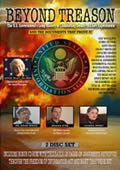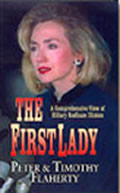AULD
LANG SYNE: 2009 TO 1929
PART 2 of 3
By
Jon Christian Ryter
January 11, 2009
NewsWithViews.com
ABC News correspondent John Stossel, writing a syndicated column that appeared on Dec. 28. 2008 in the Manchester Union Leader noted that President-elect Barack Hussein Obama has the same deeply-rooted arrogant character-flaws found in Franklin Delano Roosevelt. FDR used a banker-instigated recession to completely remake the US economy from 1933 to 1939, replacing a constitutional republic with a constitutional democracy. Obama plans to use the Recession of 2008 to complete the constitutional renovations started by Roosevelt in 1933. When he's done, the government of the United States will look the governments of any of the other subservient nation-states of Europe just before they were sucked into the political black hole of the European Union.
Barack Hussein Obama, the unconstitutional non-citizen president who has no emotional ties to this nation, will serve as the funeral director in the soon-coming demise of the United States of America as we knew it on New Year's Eve, 2008. Stossel noted that Obama plans to use the Recession of 2008 to remake the US economy, quoting Obama, who said: "Painful crisis also provides us with an opportunity to transform our economy, to improve the lives of ordinary people." Obama promised change throughout his campaign. Sadly, no one asked him what type of change he had in mind. Had they asked, and had he answered them honestly, Barack Hussein Obama would not have won a single State or a single electoral vote. Illinois Congressman Rahm Emanuel [D-IL], Obama's designated Chief-of-Staff was more honest in his observation of the opportunity before them. "You never want a serious crisis to go to waste," he said.
No one understood that quip better than FDR. He, also, had no intention of letting the Recession of 1929 go to waste. Like Obama and scores of other contemporary politicians who have found themselves squeezed by the money Mafia, Roosevelt believed he could manipulate the economic and societal structure of America in order to create a utopian democracy in which, he believed, all men would equally share the cornucopia of the land of plenty.
As noted in his diaries and private papers, the change FDR wanted to make could not take place in a republican form of government. Roosevelt's "New Deal" would alter, for all time, the form of government created by our Founding Fathers. Obama's "change" will complete the transformation. What Roosevelt needed was a national banking crisis so catastrophic that he could justify mandating a bank holiday, followed by a proclamation that would allow the Secretary of the Treasury to seize all of the gold that backed the nation's monetary system and, finally, the removal of the US monetary system from the gold standard without a constitutional amendment. The central banks of the world were removing the world's money supply from the gold standard and creating a global fiat monetary system. But that would not work if the US dollar remained on the gold standard.
The Federal Reserve's loose money policies in the 1920s provided the recipe for disaster. Not only did the Fed loosen the money supply by 44% to provide over $10 billion in mortgage money for the nation's returning doughboys, home from the war; but private investors led by JP Morgan and John D. Rockefeller, Jr. poured $286 billion into Wall Street to finance the working class' venture into the stock market where they were encouraged to share in the great American dream.. To hook the working class, Wall Street utilized a new tool to entice novice investors to speculate in the market. It was called "buying on margin." With a modest 10% down payment, with the balance financed by credit supplied by the broker from a money pool supplied by private investors, everyone was getting rich—on paper. Home owners pledged their mortgages and deeds on their homes against the loans taken on their retirement nest egg portfolios.
For the first time in the history of the New York Stock Exchange [NYSE] hordes of common, working class investors were "in the market." It became commonplace to see blue collar workers on the subway reading the financial page instead of the sports page. Housewives used their milk money to buy penny stocks. Factory workers who had been betting the ponies now bet on the market. Overnight, ladies' bridge clubs became investment clubs. Taxi drivers provided their fares with the latest stock market tips. Buying was easy. Working class investors were led to believe the day of reckoning would never come. On paper, America had more millionaires from 1921 to 1929 than during any other period in the history of the market. However, the real wealth was owned by the Wall Street bankers who financed the debt and assumed none of the risk. When the final crash toppled the market on Black Tuesday, October 29, 1929, they would own the collateral that was pledged against the margin calls none of the working class investors ever thought would happen. America was bust, but America's wealthy elite became even richer as they picked up the bargains lost by novice investors who panicked and sold, or could not make their margin calls and lost everything—even their mortgaged homes.
Does any of this sound familiar? Take a moment and compare the parallels between the consumer economics of 1921-1929 and those of 2001-2009. Today, almost every company in America that offers their employees a retirement program invests—or rather, allows their employees to invest—their 401K contributions in the stock market. The risks are assumed by the employee and not the company. Add putting the working class investor back into the stock market as they were in the Roaring 20s with the 2001 housing boom in which a half-trillion dollars worth of high-risk, subprime mortgages were sold and you have 1929 all over again. Only, this time around, the bankruptcy laws were "updated" with the Bankruptcy Abuse and Consumer Protection Act of 2005 [BACPA] to make sure this decade's debtors can't escape the debt they created.
Even if they go "bust," the likelihood is that they will continue to owe their creditors a part of their debt [the principle of the debt minus the interest] since today's bankruptcy laws make it more difficult to file Chapter 7. Only the "true poor," (those below or near the poverty level can safely file Chapter 7 and discharge their debts.) Prior to 2005, any debtor could file Chapter 7 bankruptcy. All that was needed was that their debts exceeded their net worth.
Now, that's no longer enough for middle class consumers who lost their jobs and no longer have the income to discharge their debts. The Bankruptcy Abuse and Consumer Protection Act of 2005 establishes a new method for calculating the debtor's median income in the debtor's State. If the debtor earns more than the median average in his or her State, a "mean test" is then applied to determine if the debtor has abused spending "norms" for consumers of average means in his State. The spending "norms"are determined by IRS guidelines (which were calculated over four decades ago and were never adjusted for inflation. That means virtually no one qualifies for debt elimination bankruptcy today.) Today, the odds are that the Chapter 7 filing will be converted by the Bankruptcy Referee into a Chapter 13 filing and a bankruptcy court will determine what portion of the outstanding debt must be paid to the creditor. BACPA also requires debtors to take classes in debt management.
There was a time before the lawyers of quid pro quo lobbyists on K Street in Washington, DC began writing the bills to tailor legislation like the Bankruptcy Abuse and Consumer Protection Act of 2005 to specifically benefit their clients—the banking and credit card industry—that regulatory checks and balances existed which controlled corporate behavior on Capitol Hill. Ethics seems to have vanished in Washington. Laws that punish both corporate donors seeking quid pro quos for their million dollar "campaign contributions" and ethically-bankrupt politicians with freezers full of money have been weakened dramatically over the last 100 years as quid pro quo politics has been legalized as long as both parties observed certain rules that politicians crafted to surreptitiously erase the underpinnings of political ethics in America.
[Read "The Coming Battle" published in 1899 how recessions were created through the 1800s]
When he was running for office, FDR climbed into bed with the AFL-CIO. He took their money, and he took the sweat equity of thousands of union workers who donated their time to the Roosevelt Campaign for a decade, embedding the AFL-CIO into Democratic politic, and giving unions the strength to strangle the competitiveness of US industry in a global economy—which is why so many US corporations have now completely fled from the United States. During the Roaring 20s, America largely ignored war-torn Europe except to sell it goods and services. The leaders of Europe pleaded for America to open its markets to tariff-free goods while demanding the right to impose stiff tariffs on US goods.
The utopians in the small feudal States of Europe who joined the League of Nations to forge a United Europe similar to the United States, believed the solution to ending war for all time was to outlaw war by outlawing the manufacturing of weapons of war. The League of Nations was to create a global economy using a global monetary system, regulated by a global legislature. The League failed during the Roaring 20s, but the globalists were determined to create a catastrophic financial crisis so severe that the only solution would be the tutorial world government already headquartered in the Hague in Brussels, Belgium.
On Black Tuesday, Oct. 29, 1929 England's Chancellor of the Exchequer Winston Churchill, who had just resigned after a bitter fight with Britain Prime Minister Stanley Baldwin over his decision to temporarily restore the British Pound Sterling to the gold standard, was financier Bernard Baruch's guest on the floor of the NYSE. Baruch wanted to prove to Churchill, a popular political figure in England, that even a gold and silver-backed monetary system could not withstand the whims of the lords of industry, the barons of banking and the merchant princes. Churchill was to be a witness to the deliberate, well-staged collapse not only of the financial infrastructure of the United States, but the insolvency of the American dollar that was fed by the demands of transnationalists exchanging their fiat monetary investments in America for gold.
The Stock Market Crash of 1929—like all major market slides—was a carefully-staged dichotomy. To market watchers, two thoroughly unrelated events came into play simultaneously guaranteeing what happened would happen. First, there was a major sell-off by the nation's largest investors who sold the bulk of their portfolios and moved their money to the foreign gold markets. (Since the price of gold was artificially-depressed by the United States government, the bellwether that tells the world that the money barons are manipulating the market did not work.) Left in the portfolios of the money managers were enough remnant shares to prime the suction pump for a second run and trigger the collapse of the market.
First, on Thursday and Friday, Oct. 24-25, 1929, thousands of small investors all over the country beat a path to their local banks to withdraw years of savings to meet the margin calls from Thursday. This caused a massive drain on the cash reserves of the local banks, making new loan requests on Tuesday, Oct. 29, under the Fed's fractional reserve system regulations, impossible. Compounding the problem, when they should have eased reserve requirements and eased the strain on the market, the Fed increased reserve requirements and shrank the money supply. The action was deliberate and calculated to accomplish precisely what happened.
|
Subscribe to the NewsWithViews Daily News Alerts! |
On Tuesday, Oct. 29 the "dump" order to key brokers across the country came from the investment bankers. As the money barons dumped the balance of their stock, prices plummeted. Brokers all over the country began calling in 24-hour demand notes. Panic set in as blue collar investors who had pledged their homes on Main Street, America to live the Great American Dream on Wall & Broad Streets suddenly discovered they were living the Nightmare on Elm Street. For part three click below.

















